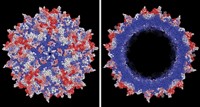Advertisement
Grab your lab coat. Let's get started
Welcome!
Welcome!
Create an account below to get 6 C&EN articles per month, receive newsletters and more - all free.
It seems this is your first time logging in online. Please enter the following information to continue.
As an ACS member you automatically get access to this site. All we need is few more details to create your reading experience.
Not you? Sign in with a different account.
Not you? Sign in with a different account.
ERROR 1
ERROR 1
ERROR 2
ERROR 2
ERROR 2
ERROR 2
ERROR 2
Password and Confirm password must match.
If you have an ACS member number, please enter it here so we can link this account to your membership. (optional)
ERROR 2
ACS values your privacy. By submitting your information, you are gaining access to C&EN and subscribing to our weekly newsletter. We use the information you provide to make your reading experience better, and we will never sell your data to third party members.
Gene Therapy
Capsida raises $140 million for targeted AAV gene therapies
AbbVie is partnering with the Caltech spin-off for gene therapies for neurodegenerative diseases
by Ryan Cross
April 29, 2021
| A version of this story appeared in
Volume 99, Issue 16

Capsida is the latest start-up to debut flush with cash and plans to develop safer and more effective gene therapies. The Thousand Oaks, California–based company is developing new adeno-associated viruses (AAVs) designed to deliver genes to specific types of cells in the brain.
Capsida, whose name refers to the capsid, or shell, of an AAV, announced that it has raised $50 million in series A financing from Versant Ventures and Westlake Village Biopartners. It has also struck a partnership with AbbVie to work on three gene therapies for neurodegenerative diseases. AbbVie will pay Capsida $80 million up front and make a $10 million equity investment. Capsida could earn an additional $530 million in milestone payments.
There are two AAV-based gene therapies approved in the US. Although multiple experimental AAV gene therapies are in clinical development, many scientists see a need for better AAVs.
The first generation of AAVs, which are based on naturally occurring viruses, are not very effective at delivering genes to certain cell types, such as muscle cells. Biotech companies have tried to resolve this problem by using high doses, but they have led to dangerous, and sometimes deadly, immune reactions. Furthermore, gene therapies for neurological diseases often must be injected directly into the brain or spinal cord, and even that invasive approach doesn’t always get the gene to the right cells in the nervous system.
Capsida CEO Robert Cuddihy says his firm can make gene therapies more effective by engineering AAVs to target a specific kind of cell in the body and avoid targeting other cells such as those in the liver, which often soaks up most intravenously injected AAVs. And by creating AAVs that are effective at delivering genes to the right place, Cuddihy thinks his company can use lower doses and reduce the risk of immune reactions.
The company is based on the work of Caltech scientist Viviana Gradinaru, whose lab devised a system for engineering billions of AAVs to find new versions that have an affinity for a certain cell type. In 2017, her lab even discovered AAVs that could be injected intravenously, cross the blood-brain barrier of mice, and deliver their cargo to neurons. If the approach can be replicated in humans, it could lead to gene therapies for neurological diseases that don’t require invasive injections into the brain or spinal cord.
Gradinaru and two scientists in her lab, Nicholas Flytzanis and Nick Goeden, teamed up with the venture capital firms Versant and Westlake to quietly launch Capsida in 2019. Flytzanis is currently vice president of research, and Goeden is vice president of technology. Cuddihy says the start-up has already grown to 60 people, and he expects the headcount to pass 100 before the end of the year.
Capsida is one of several start-ups interested in designing improved AAVs. For instance, Dyno Therapeutics, which is using artificial intelligence to discover new AAVs, has already struck partnerships with Novartis, Roche, and Sarepta Therapeutics to develop gene therapies targeting the central nervous system, eye, muscles, and more. Stride Bio is developing novel AAVs for partnerships with Crispr Therapeutics, Sarepta, and Takeda Pharmaceutical. And the AAV design company Affinia Therapeutics has struck a gene therapy partnership with Vertex Pharmaceuticals.
The need for new AAVs is evidenced by the number of partnerships these young start-ups are striking and the speed with which they are doing it. “It speaks to the broad interest of pharma companies in gene therapy,” says Clare Ozawa, a managing director at Versant and member of Capsida’s board.
However, Capsida was not created simply to make new AAVs for bigger firms to use, Ozawa adds. Novel AAV development is just one of three components of Capsida, says Beth Seidenberg, founding managing director at Westlake. Capsida is also developing expertise at improving the genetic cargo delivered by the AAVs, and it has plans to open its own manufacturing facility later this year, she says.
Cuddihy says Capsida is screening billions of engineered AAVs in monkey and human tissue models to find viruses that are good at entering certain cells—such as neurons, microglia, and astrocytes—and bad at entering others. Since many intravenously injected AAVs naturally end up in the hepatocytes of the liver, Capsida scientists are trying to make AAVs that don’t target liver cells.
Capsida’s initial focus is on neurodevelopmental and neurodegenerative disorders, although Cuddihy won’t name specific diseases yet. He says the firm’s first clinical trial could begin in 2022.





Join the conversation
Contact the reporter
Submit a Letter to the Editor for publication
Engage with us on Twitter